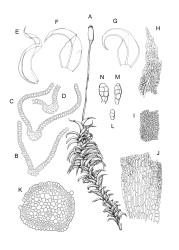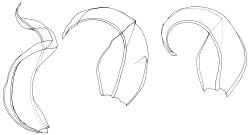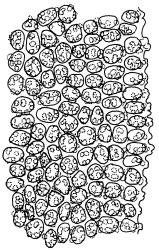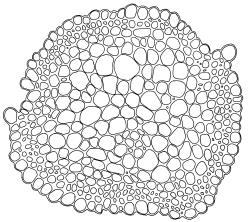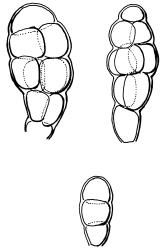- ≡ Didymodon interruptus Mitt. in Hooker, Handb. New Zealand Fl. 421 (1867)
Plants yellow to yellow-green above, green when shaded, brown below, in loose tufts or mats, on soil or rock. Stems to c. 60 mm, simple or infrequently and irregularly branched, often with comal leaf tufts, in cross-section central strand absent, sclerodermis present, hyaloderm present. Leaves squarrose-recurved and twisted round the stem when moist, loosely appressed and lightly individually twisted with apices spreading when dry, 2–3 mm, lanceolate from a sheathing, broad and ovate base, carinate and not lying flat under coverslip distally, acuminate; margins recurved in the lower ½–⅔, undulate, papillose, crenulate (from bulging cell walls), and irregularly dentate in upper ⅕; upper laminal cells obscure, isodiametric to quadrate, shortly rectangular or oblate, firm-walled, evenly thickened or weakly thickened in corners, densely pluripapillose with predominantly bifid papillae, (7.5–)9–10.5(–12) × (7.5–)9–10.5(–12) µm; upper marginal cells not differentiated; lower laminal cells gradually transitioning from upper laminal cells, long-rectangular, to 75 µm long, sparsely and uniseriately papillose with longitudinal walls thick and porose, 2–3 rows quadrate at the leaf margin forming a weak border, smooth and yellow in the extreme leaf base. Costa concolorous, usually failing c. 10 cells before the apex; adaxial superficial cells thick-walled, elongate, smooth; abaxial superficial cells thick-walled, elongate, finely and densely papillose throughout; in cross-section with two exposed stereid bands. Laminal KOH colour reaction yellow. Brood bodies in the form of clavate gemmae sometimes present on short stalks in leaf axils.
Dioicous? Perichaetia with leaves little differentiated, erect, and with sheathing basal zone of rectangular cells longer than in vegetative leaves, extending to ½ leaf length. Perigonia not seen. Setae slender, flexuose, yellow to pale brown, 6–8 mm. Capsules extremely rare in N.Z., erect, symmetric, ellipsoid with a tapering neck, pale brown, red at the mouth, 1–1.5 mm. Operculum conic, suberect, obtuse, c. ½ the theca length. Peristome short (c. 220 µm), pale orange, of 16 erect teeth, irregularly perforated or cleft, smooth, nodose, lacking a basal cylinder. Spores (9–)10–12(–13) µm, smooth.
Sainsbury 1955, pl. 28, fig. 1; Malcolm et al. 2020, pp. 556–557.
The undulate leaf margins, wet or dry, and the presence of sizeable teeth on the leaf margins close to the leaf apex, will readily distinguish this moss. When shoots are moist, the leaves are strongly recurved and tend to spiral around the stem, clearly so when viewed from above. The clavate gemmae (which may be present in abundance in the axils of the leaves) are also a definitive feature.
Triquetrella papillata, with which L. interruptum often grows, has leaves appressed to the stem when dry, thus forming much more slender and rope-like shoots, and spreading when moist (vs squarrose-recurved in L. interruptum). In addition, in T. papillata the leaf margins are without teeth, and not undulate (vs irregularly dentate near the apex and undulate in L. interruptum).
Robust shoots of Gertrudiella torquata have been confused with L. interruptum, but its leaves are erect-spreading when moist (vs squarrose-recurved in L. interruptum), with no tendency to curve around the stem when moist. Barbula calycina, another robust, yellowish moss of exposed sites, is similar to L. interruptum in several microscopic leaf characters: lower laminal cells rectangular and uniseriately papillose in the transition from upper laminal cells, with a costa that is densely papillose abaxially. However, Barbula calycina differs in having plane and entire leaf margins (vs recurved and dentate margins in L. interruptum).
NI: N Auckland, including offshore islands (TK, HC, GB, RT), S Auckland, Gisborne, Hawke’s Bay, Wellington (including KA); SI: Nelson, Marlborough, Canterbury, Westland, Otago. The species is more abundant in the northern part of its range.
Endemic. The only extra-N.Z. record (see Zander 1993, p. 311) appears to be from Amsterdam I., in the southern Indian Ocean. That specimen has not been seen, and the species is provisionally regarded as a N.Z. endemic.
Terrestrial on soil, sand or rock, usually in exposed sites, but common also in mānuka (Leptospermum scoparium) or kānuka (Kunzea ericoides) shrubland, where it may cover several square metres. This moss may be present in highly modified sites, such as on gravel at the edge of a tar-sealed road, or in less disturbed sites such as a cliff-top rock platform on Manawatāwhi / Three Kings Is (J.E. Beever 87-71 & R.E. Beever, WELT M032528). On sand it may have a role in dune stabilisation, as at Kaitoke, Aotea / Great Barrier I. (J. Ogden s.n., AK 352063). The lectotype specimen is intermixed with Rosulabryum subtomentosum, and the syntype with Campylopus sp., Hypnum cupressiforme and Sclerodontium pallidum. In modern gatherings, frequently associated mosses are Campylopus introflexus, Hypnum cupressiforme, Thuidiopsis furfurosa, and Triquetrella papillata.
Records range from near sea level to 900 m (Mt Arthur, Nelson L.D.).
According to Stone & Scott (1981), reports of Leptodontium interruptum in Australia are based on misidentifications of L. paradoxum, which differs, inter alia, in having entire leaf margins, as seen in a Western Australia specimen (Drummond 36b, Swan River, BM 000845884).




